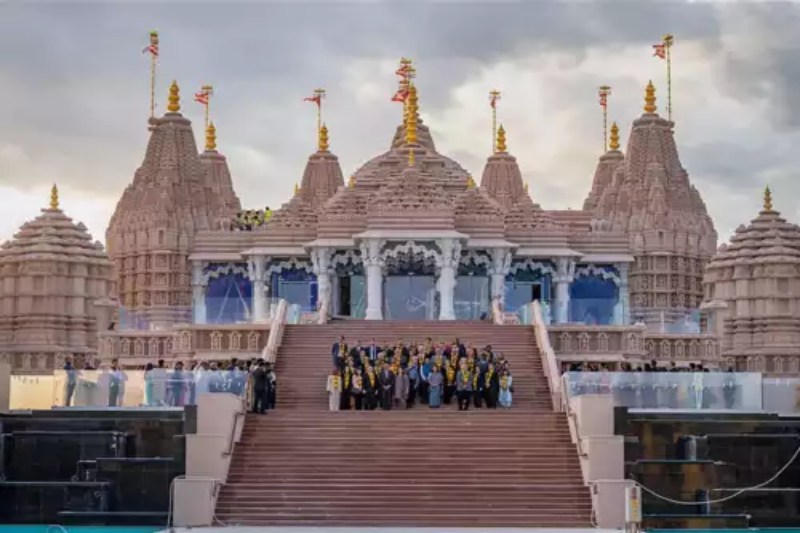PM Modi Inaugurates First Hindu Temple in UAE, BAPS Mandir

Just a few weeks after dedicating the Ram shrine in Ayodhya, Prime Minister Narendra Modi is scheduled to inaugurate a significant shrine in Abu Dhabi.
The BAPS Mandir is the first Hindu temple in the Abu Mureikhah neighborhood in the capital of the United Arab Emirates (UAE).
Three further Hindu temples in the United Arab Emirates are situated in Dubai. The BAPS temple will be the biggest in the Gulf, spanning a sizable expanse and featuring stone architecture.
That’s all there is to the temple.
About the Abu Dhabi BAPS temple
The UAE decided to set aside land in Abu Dhabi for the construction of a temple during PM Modi’s first visit there in 2015.
The prime minister’s visit was significant diplomatically since she was the first Indian prime minister to visit this strategically significant Gulf state in 34 years, following Indira Gandhi.
The temple project was officially launched by the PM in February 2018, and work on it began in December 2019.
The sacred Basant Panchami falls on February 14, 2024, which is also the day of the temple’s consecration ceremony.
The way it was built and designed
The finishing touches are already being applied on the BAPS Hindu temple, which rises majestically amid the desert sands of Abu Dhabi.
The temple was built at an estimated cost of Rs 700 crore and occupies 27 acres of land in Abu Mureikhah, next to Al Rahba, along the Dubai-Abu Dhabi Sheikh Zayed Highway.
The massive complex is 32.92 meters (108 feet) high, 79.86 meters (262 feet) long, and 54.86 meters (180 feet) wide, making it an impressive structure.
Among the temple’s many amenities are a sizable amphitheater, prayer rooms, a gallery, a library, themed gardens, water features, a food court, a gift store, a majlis, and two community halls with space for 5,000 people.
According to the news agency, the temple is being constructed with a marble façade and pink sandstone that has elaborate carvings that were brought from northern Rajasthan.
“The choice of these stones, known for their durability against scorching temperatures reaching up to 50 degrees Celsius, reflects the practical considerations for the UAE’s climate.,” PTI quoted Som Singh, a Rajasthan artisan who sculpted statues for the temple and later moved to the UAE to work at the site, as saying.
Fly ash was used into the concrete mix of the foundation as a green tactic to reduce carbon emissions. It is important to note that this project is unique in that, according to Financial Express, it is the first traditional Hindu temple to undergo rigorous digital modeling and seismic simulation.
According to the article, there are 100 sensors in the temple’s foundation and over 350 sensors positioned strategically around the building to continuously collect data on temperature variations, pressure changes, and earthquake activity.
Against a background of sandstone, over 25,000 pieces of stone have been carved into beautiful sculptures. Twelve Samrans (dome-like structures), 402 pillars, seven Shikhars (spires) representing the seven emirates of the United Arab Emirates, and two Ghumats (domes) are present.
The art and architecture of the Vedas served as inspiration for the temple’s design. Each Shikhar is adorned with elaborate carvings that, according to PTI, tell tales of Lord Jagannath, Lord Swaminarayan, Lord Venkateshwara, and Lord Ayyappa in addition to stories from the Ramayana, Shiv Purana, Bhagavatam, and Mahabharata.
For a distinctively regional touch, camels—a symbol of tenacity, devotion, and endurance—have been carved into the statues. The “Dome of Harmony” offers a distinctive representation of the five elements of nature—earth, water, fire, air, and space—in harmony.
The manager overseeing building of the temple, Madhusudan Patel, stated to PTI, “We have overcome obstacles and used creativity in our journey.” He disclosed that the integration of historic and contemporary stone structures has been achieved through the use of heat-resistant nano tiles and thick glass panels.
Over 1.8 million bricks, 180,000 cubic meters of sandstone, and 40,000 cubic meters of marble—including Italian marble—were used to build the temple. More than 700 containers carrying more than two lakh cubic feet of “sacred” stone have been brought for the temple’s construction, according to Vishal Brahabhatt, the site supervisor for procurement and logistics.
Concerning the organization
The abbreviation BAPS stands for Bochasanwasi Shri Akshar Purushottam Swaminarayan Sanstha. The name of the organization is derived from the Hindu guru Bhagwan Swaminarayan, who lived in the late 1700s.
As per the website of BAPS, it is a Hindu religion that is socio-spiritual and has its roots in the vedas. Shastriji Maharaj (1865–1951) formed the religion in 1907, and Bhagwan Swaminarayan (1781–1830) pioneered it in the late 18th century.
The BAPS claims to be in charge of 3,850 units worldwide and 1,100 temples. The temples of Akshardham in Delhi and Gujarat are also administered by the BAPS.
Additionally, the organization was in charge of building Akshardham, the biggest Hindu temple outside of India, in Robbinsville, New Jersey. Akshardham Mahamandir is a 191-foot-tall structure that sits atop 185 acres in New Jersey, 99 miles south of New York City. The temple was constructed using 1.9 million cubic feet of stone that were shipped from over 29 different countries, including Bulgaria, Italy, Greece, Turkey, and India.